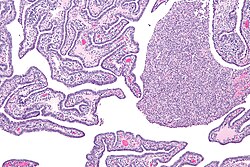Puerperal fever
Template:Infobox - disease Puerperal fever is a septic condition arising from endometritis (purulent or putrefactive) following childbirth or abortion - endometritis post partum, abortum.
Causative agents[edit | edit source]
The most common causative agent is β-hemolytic streptococcus, staphylococci or anaerobes (Clostridium welchii, C. tetani).
Infection entry pathway[edit | edit source]
The most common route of infection is via the cervix, most often during unprofessional childbirths or criminal abortions.
Pathogenesis[edit | edit source]
After birth of the placenta, the inner surface of the uterine cavity appears as a large open wound covered with clots – bacteria easily attach and multiply creating a purulent infection (macroscopically the uterus is enlarged, the mucosa is hemorrhagic, pus-covered, with necroses, during putrid endometritis it is covered with smelly gray-green masses and during infections with gaseous anaerobes(Clostridium perfringens seu welchii)the gas accumulates in the uterine cavity- so-called physometra).
Inflammation can spread further:
- To the muscle of the uterus – myometritis (phlegmona of the smooth muscle, sometimes creating abscesses), then to the parametrium and perimetrium – blood and lymphatic vessels are affected in all layers, leading to peripheral pyemia.
- Into the uterine tube – purulent salpingitis – from here it spreads into the peritoneal cavity (milder pelveoperitonitis, or severe diffusedperitonitis).
Complications[edit | edit source]
- Resorption of toxins and putrefactive products.
- Generalization of infection (septicopyemia to sepsis).
- Peritonitis.
Links[edit | edit source]
Related articles[edit | edit source]
Used literature[edit | edit source]
- PASTOR, Jan. Langenbeck's medical web page [online]. [cit. 2011-07-11]. <http://langenbeck.webs.com>.




